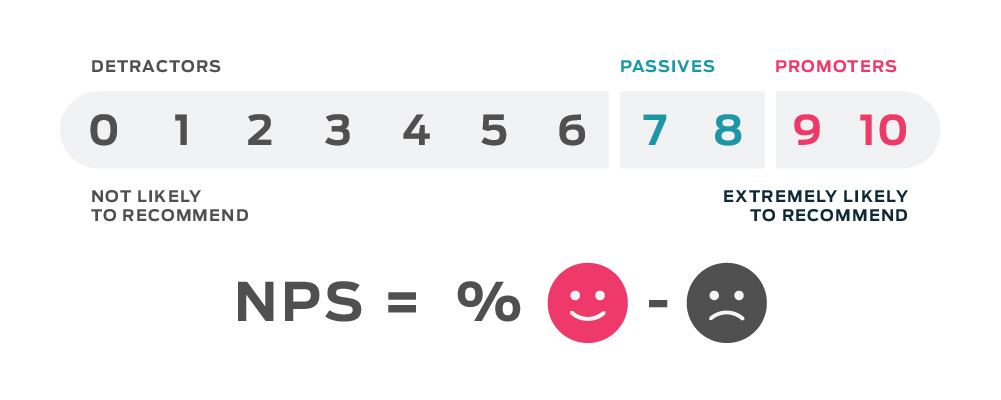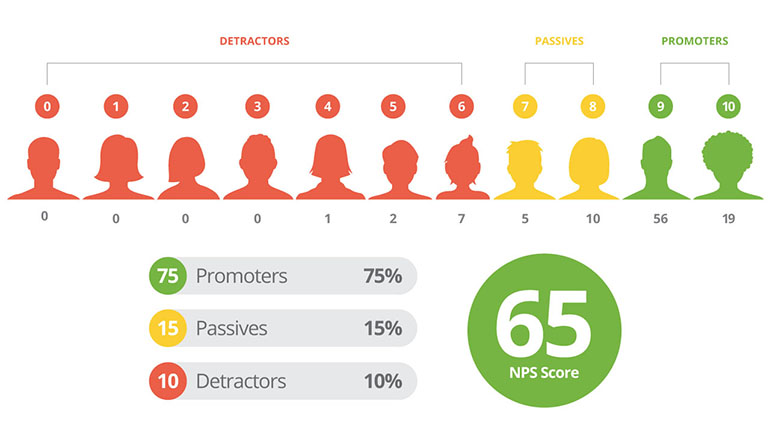If you’re a business owner, and someone asks you how your customers feel about your business, your response might be something like, “I think they feel good about it?” But if you don’t have any data to confirm this, then you’re stuck in the realm of speculation — and that doesn’t really help you.
With a metric like Net Promoter Score (NPS), calculated using the NPS score scale, you can gain a real sense of customer happiness and loyalty. Why does this matter? Because happy, loyal customers are usually eager to talk about your business to others. And since word-of-mouth referrals, whether offline or online, are a reliable source for new business, using NPS to your advantage is important.
Here’s a simple guide to help you understand NPS more clearly and learn how to calculate your Net Promoter Score on a 10-point scale.
What is Net Promoter Score?
NPS measures how your customers feel about your business and how likely they are to tell others about it. Said another way, it’s a great way to judge word-of-mouth referrals, which are important sources of new business since they come from trusted sources: friends and family vs. an advertising campaign.
In practice, NPS is a number — or score — you get from doing a survey of your customers. The score represents customer sentiment and is easy to understand and communicate. NPS can be used by any business, large or small, to better understand how customers feel and determine if improvements should be made.
NPS has been around for a while; Harvard Business Review first wrote about NPS almost 20 years ago. It remains such a good indicator of customer happiness and loyalty that it’s used by two-thirds of the Fortune 1000 today. And it’s why NPS is still the first question we ask in our feedback process.
What is the NPS Score Scale?
The NPS score scale is a 0-10 point scale with 10 being very likely to refer and 0 being not likely at all. To get your score, all you need to do is conduct a simple survey that asks your customers a single question: “How likely are you to refer a friend or colleague to our business?” The customers then answer the question by assigning a number from the scale, as shown below.

You then divide the answers into three categories: Promoters, Passives, and Detractors. Before we discuss how to calculate your final score, here’s a look at each category and what they tell us about the customers that fall into them:
Promoters
Promoters rate you a 9 or 10 on the question. As the category name implies, promoters — also referred to as brand advocates — are the customers who champion your business by telling others to buy from you. They might even be so thrilled with your business that they’ll talk about it unprompted.
Real-life example: Your neighbor walks into the neighborhood pool party and out of nowhere starts telling everyone about the company that just painted his house. He raves about how they were affordable, meticulous, and so easy to deal with. While he’s talking, a few people look up the house-painting business on their phones and add the number to their contacts.
That’s a promoter: They give you tons of free marketing by enthusiastically sharing their great experiences and positive opinions.
Passives
Passives rate you a 7 or 8 on the question. These customers may have had a decent experience with your business, but nothing really wowed them. As such, they don’t have anything bad to say about you, but they won’t go out of their way to say anything good either.
Real-life example: You’re talking to a coworker one day and she tells you about the resort she just went to on vacation. When you ask how the resort was, she says, “It’s fine. Nothing great. Nothing bad. But I might try another place next time.”
Passives give you their business once or twice, but are basically indifferent to it. They’re ambivalent about returning and they see no real reason to recommend it to anyone.
Pro tip: Passives actually get left out of the NPS calculation, as we’ll show below. But that doesn’t mean this group isn’t important. You need to know they exist — and how many there are — so you can figure out how to move some of them up to being a promoter, since turning passives into promoters can help grow your business. But you also want to make sure that passives don’t dip down into the category we’ll look at next.
Detractors
Detractors rate you anywhere from 0 to 6. In the eyes of these customers, your business falls short — could be a few inches, could be a mile (especially if they rate you a 0 or 1). Detractors are the opposite of promoters. Instead of singing your praises, they tell their friends, family, neighbors, and anyone who’ll listen to avoid your business at all costs.
Real-life example: You meet up with your best friend for a beer and after some small talk he asks you if he’s told you about his current real estate agent. He then goes on a 10-minute rant about how the agent never answers his calls, doesn’t follow up until days later, and repeatedly messes up paperwork, causing additional delays and wasted time. He’s not going to use this agent ever again and won’t refer them to anyone else either. You realize you’re not the only one he’s going to rant to about this.
Detractors aren’t just disgruntled customers. They can actually take business from you.
How to calculate your NPS score: The NPS formula
Now that you understand the different customer categories, here’s how to calculate your score:
- Add up all your promoters, passives, and detractors. Let’s say you have 68 promoters, 14 passives, and 23 detractors, for a total of 105 survey respondents.
- Divide the number from each category by the total number of survey respondents to get a percentage. For example: 68 promoters divided by 105 total respondents = 64.7%, or you can round up to 65%. 23 detractors divided by 105 total respondents = 21.9%, or you can round up to 22%.
- Subtract the percentage of detractors from the percentage of promoters. So that’s 65% (promoters) minus 22% (detractors) = 43. (Remember: passives don’t get factored into the calculation.)
- The final number you get is your score — in this case, 43.
If you don’t want to do the math yourself, you can use a free NPS calculator online.
Here’s an easy way to visualize the NPS formula:

And here’s a simplified example of 100 customers answering the Net Promoter Score question and how the results are calculated for that business:

What your NPS score means
Once you calculate your score, then you need to figure out what it’s telling you. At minimum, the NPS ratings scale and formula should help you understand how likely your business is to grow based on how likely your customers are to recommend it to others.
Here’s a basic breakdown of the score ranges, but keep in mind that these ranges can vary by industry. This is just a simple way of looking at it:
- -100 to 0: Poor and needs improvement
- 1 to 30: Average
- 31 to 70: Good
- 71 to 100: Exceptional (nobody gets 100, so don’t feel you have to chase that)
Why NPS matters to your business
NPS is an important indicator of how your business is doing, giving you insights into:
- Business growth
- Customer churn
- The customer experience
- Customer loyalty
- Effectiveness of your customer service
- Influence of online reviews
If you run a small business, tracking and measuring NPS can make a big difference in your ability to retain customers and stay competitive. While many businesses may be willing to fly blind and never really know what their customers think, you don’t have to. NPS can give you an advantage over the competition by understanding your own customers that much better so you can make meaningful improvements that focus more on what your customers most like about your business.
If you run a multi-location or franchise business, NPS is a fantastic way to get location-specific insights in addition to brand-level insights. And if you run a digital agency, you can track NPS for each of your clients to help inform branding and marketing strategies.
Any business can benefit from the simple power of NPS to capture customer feedback, benchmark where your business is at, and communicate how your business is doing with your staff so you can constantly improve, grow, and succeed.
To learn how GatherUp’s customer feedback and NPS reporting capabilities can help your business, start a free trial.